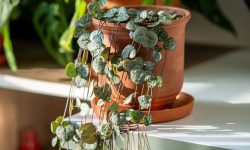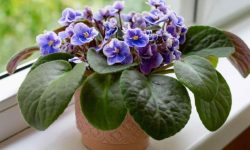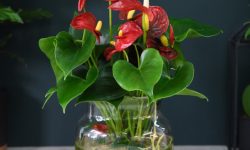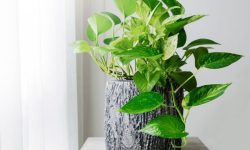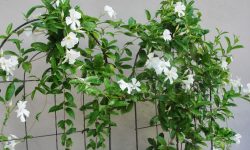Alocasia, known for its captivating and dramatic leaf patterns, has become a popular fixture in contemporary home decor. With its characteristic long petioles and eye-catching foliage, the Alocasia plant effortlessly adds a touch of natural elegance to any living space. In this article, we delve into the diverse world of Alocasia varieties, presenting a detailed exploration of their distinct names and vibrant visual representations.
Regarding Alocasias
Alocasias, native to Asian and Australian tropical rainforests, are nicknamed Elephant Ears due to their large leaves. With approximately 86 species, their leaf shapes vary greatly, with some featuring deeply incised leaves. Not all species are suitable as houseplants, given their potential size. Despite the variations, the arrowhead shape remains a consistent feature, albeit sometimes appearing more rounded or wavy.
Different types of Alocasia around the world
1. Alocasia alba
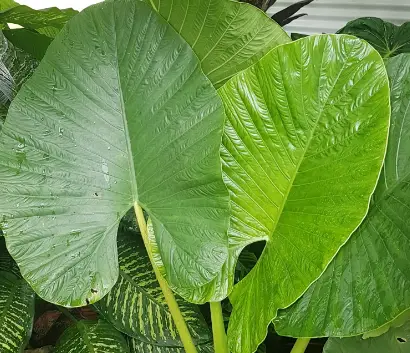
Alocasia alba is a robust herb that grows up to 2 meters (6.6 feet) tall. Each plant has several green leaves, with the upper leaves being a darker shade of green than the lower, yellowish-green ones. The leaf blades are not peltate, but rather oblong to arrowhead shaped, with noticeable secondary veins on the underside. It is commonly confused with other species, such as Alocasia bantamensis and Colocasia alba. It grows well across Indonesia, with a preference for open, shaded forests, stony or sandy riverbanks, and well-drained lowlands. Its glabrous lower leaf surfaces and petioles, green spathes with leveled constrictions, and clearly defined inter-primary collective veins are among its notable characteristics.
2. Alocasia ‘Amazonica’
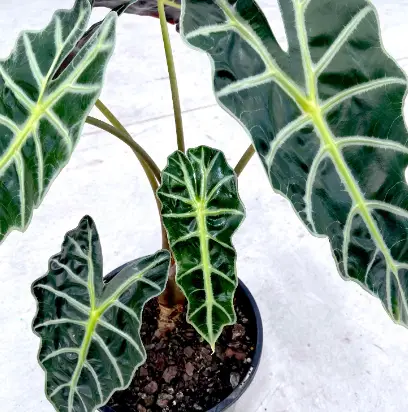
Developed by Salvadore Mauro at the Amazon Nurseries, Alocasia ‘Amazonica’ is a combination between Alocasia sanderiana and Alocasia longiloba ‘Watsoniana’. The plant comes from Asia, not the Amazon, despite its name. Alocasia ‘Polly,’ a smaller mutation of ‘Amazonica’ developed by Denis and Bill Rotolante at Silver Krome Gardens in Homestead, Florida, is sometimes confused with it by people.
3. Alocasia acuminata
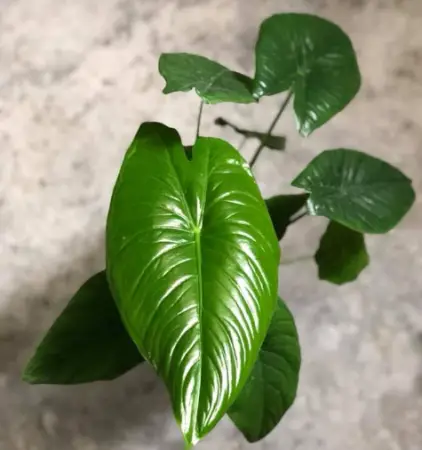
The evergreen plant Alocasia acuminata grows to a height of approximately 75 cm (29.5 inches) and has rhizomatous stems that are 8 to 75 cm (3 to 30 inches) long and 2 to 6 cm (1 to 2.5 inches) wide. It is found across Asia in moist regions of dry evergreen forests, usually growing on limestone and granite at elevations between 650 and 1,175 meters (2,132 and 3,855 feet). Its unlobed or sparsely lobed stigma, vivid green leaf laminae, simple green petioles and cataphylls, and the regular occurrence of several leaves at once set it apart from Alocasia longiloba.
4. Alocasia aequiloba
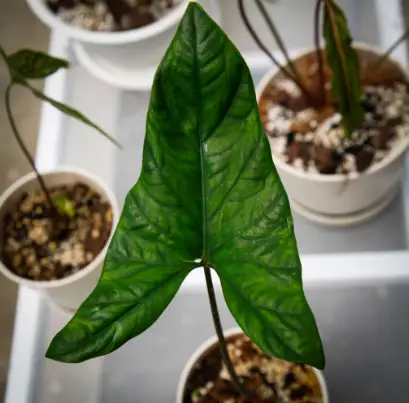
The tough herb Alocasia aequiloba has a creeping stem that can grow up to 4 cm (1.5 in) wide. Its leaves, which have glossy dark green tops and pale undersides with sporadic yellow or white flecks and host bryophytes and lichens, range in shape from pointy to arrowhead and have slightly wavy edges. It is found in the Bismarck Archipelago, Northern and Eastern New Guinea, and grows best in lowland rainforests, swamps, and regrowth areas. Notably, its long-lasting leaves sustain epiphyllous plants, and some variegated individuals spontaneously appear. ‘Gold Dust’ and ‘Spotted Papua’ are its cultivated varieties.
5. Alocasia aequiloba ‘Gold Dust’
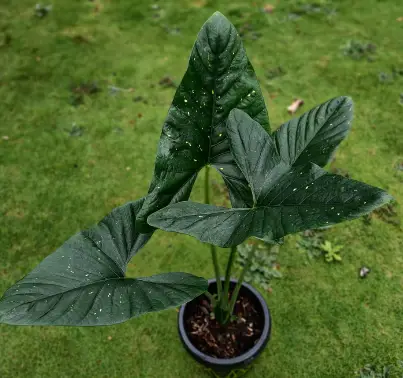
The cultivar of Alocasia aequiloba known as “Gold Dust” is distinguished by sporadic gold dots on its leaves.
6. Alocasia alba ‘Silver’
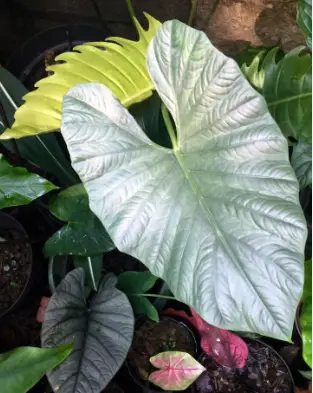
Compared to the solid green of the Alocasia alba type species, the leaves of the Alocasia alba cultivar “Silver” are whitish-silvery.
7. Alocasia ‘Albatuwan’
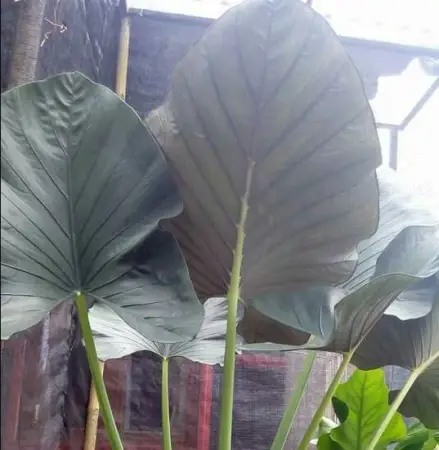
Alocasia ‘Albatuwan’ is a cross between Alocasia alba and Alocasia reginae that was first bred by Wawan at Chong Lee Nursery in Malaysia from 2001 to 2016. Wawan acquired a plant known as Alocasia ‘Batu’ while he was in Kalimantan; it was subsequently determined to be Alocasia reginae. He called the resultant hybrid, “Albatuwan,” (Alba + Batu + Wan, after his name), after crossing it with Alocasia alba. Although widely used in Malaysia, it is shipped to Thailand and Indonesia less frequently.
8. Alocasia arifolia
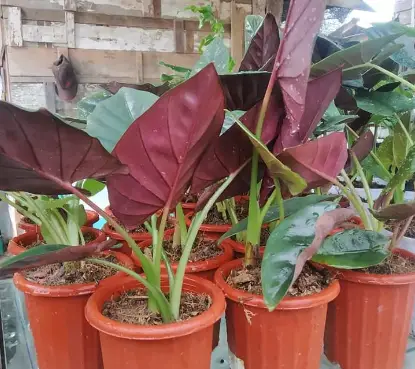
Typically growing to a height of 70 cm (28 in), Alocasia arifolia has an erect to decumbent stem that measures 2-4 cm (1-1.5 in) in diameter and 30 cm (12 in) in length. Its glossy, mid-to-dark green leaves are around 30 cm (12 in) long, shaped like spearheads to arrowheads, and their texture ranges from thinly leathery to membranous.
It is native to Sumatra in Indonesia, where it grows in low montane forests 400–1,300 meters (1,312–4,265 ft) above sea level. It does not require a lot of water, despite being frequently found next to streams.
9. Alocasia atropurpurea
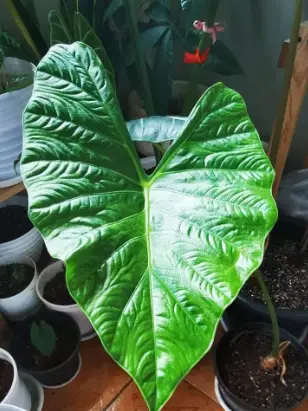
Alocasia atropurpurea is a somewhat robust herb with membranous, shallowly peltate leaf blades that are roughly 40 cm (16 in) long and resemble an egg and an arrowhead. Four major lateral veins are present on each anterior costa side, from which secondary veins may branch to form inter-primary collective veins. It is found in large karst landscapes in Northern Luzon, Philippines, mostly on limestone in open roadside habitats.
10. Alocasia ‘Aurora’
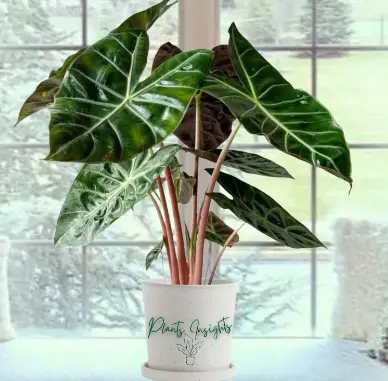
The natural hybrid Alocasia “Aurora” has unidentified parentage. The parent plant of the whole Safari Series, this plant was purchased at the Bangkok Flower Market and imported back to the United States. When it was first introduced to the US in the early 2000s, the original Alocasia ‘Aurora’ plant did not do well. As Alocasia “Pink Dragon,” it has now gained a lot of popularity in Europe.
11. Alocasia azlanii
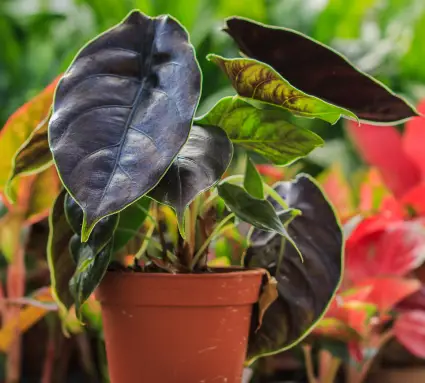
The tiny plant Alocasia azlanii grows to a height of 10 to 28 cm (4 to 11 in) and has thin stems that are 8 to 10 mm (less than half an inch) broad. Its broad, ovate-elliptic leaf blades measure 16–20 cm (6–8 in) in length and 8.5–11 cm (3–4 in) in width. The upper surface is a dark coppery purple green, while the lower surface is pale green. Both sides have pronounced principal lateral veins and sinuating margins. Originating in Borneo, it favors damp, dark areas above flood levels next to a shallow branch of the Benutan river, within mixed dipterocarp woods on sandy clays. It is noteworthy for its similarities to Alocasia beccarii and Alocasia peltata, but for its particular vein patterns and the location of the staminate zone in the lower spathe chamber.
12. Alocasia baginda
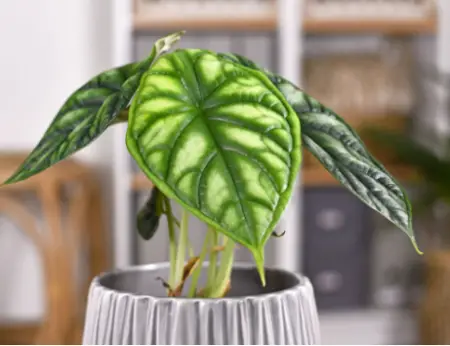
Sturdy herb Alocasia baginda reaches a height of 25–30 cm (10–12 in). Its stem emerges as a short, decumbent rhizome at the top. It usually has four spreading leaves with white speckles and pale green, 13–23 cm (5–9 in) long petioles. The broad, peltate leaf blades include primary and marginal veins that define the matte dark green and contrasting pale grey bullate parts. They measure 10–18 cm (4–7 in) long and 7–12 cm (3-5 in) wide.
This native of Borneo is easily recognized from Alocasia melo by its darker green patches, smoother leaves, and noticeable pale gray bumps. Alocasia baginda undergoes spathe constriction at the middle of the staminate flower zone, whereas Alocasia melo experiences it at the apical section of the flower zone, despite the similarities between their inflorescences.
13. Alocasia baginda ‘Dragon Scale’
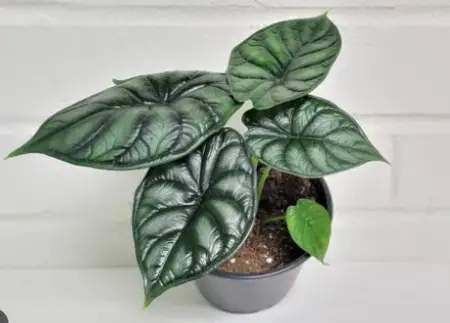
In contrast to the more subdued Alocasia baginda type species, the cultivar Alocasia baginda ‘Dragon Scale’ has darker, completely green leaf surfaces.
14. Alocasia baginda ‘Green Dragon’
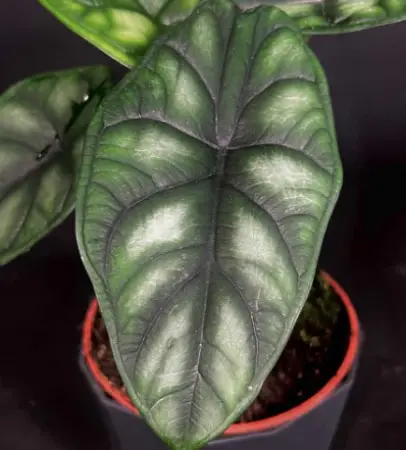
In addition to having a deeper green leaf surface reminiscent of Alocasia baginda “Dragon Scale,” Alocasia baginda “Green Dragon” is a cultivar of Alocasia baginda that shares some of the lighter silvery feathering patterns on the upper leaf surfaces with the Alocasia baginda type species.
15. Alocasia baginda ‘Silver Dragon’
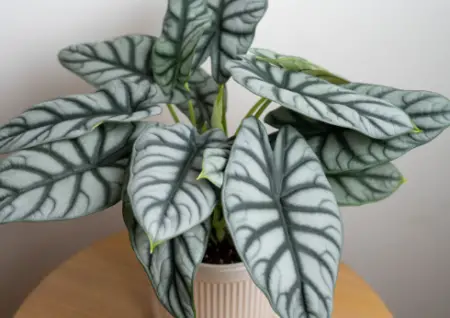
The cultivar of Alocasia baginda known as “Silver Dragon” retains the dark green vein coloration that is characteristic of Alocasia baginda “Dragon Scale,” but on the upper leaf surfaces it displays a silver interveinal coloration that fluctuates in strength depending on the amount of light available.
16. Alocasia balgooyi
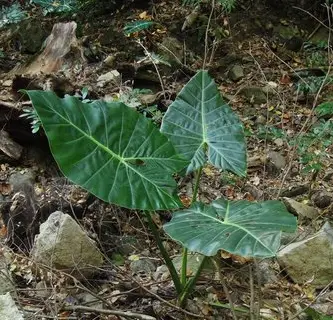
The large herb Alocasia balgooyi reaches heights of 1-3 m (3-10 ft) and has a thick rhizome covered in fibrous leaf remains. Its 50–100 cm (20–39 in) long, membrane leaves have a variety of shapes, such as an egg-arrowhead or heart-arrow.
It is native to Sulawesi, Indonesia, and grows between sea level and 1,200 m (3,937 ft) in conditions that are similar to those of Alocasia melo. It prefers ultramafic substrates found in low- to mid-elevation forests, swamp forests, rocky slopes, and disturbed regions.
Alocasia balgooyi can be distinguished from Alocasia macrorrhizos by having fewer or no exposed back ribs, a shorter leathery spathe blade, smaller synandria, and a red fruiting spathe.
17. Alocasia ‘Bambino Arrow’
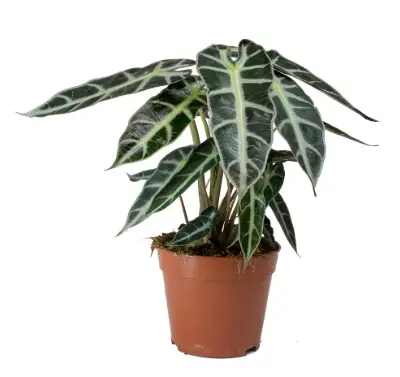
Probably a cross or mutation of Alocasia longiloba, the Dutch cultivar Alocasia “Bambino Arrow” was introduced in the early part of 2008.
18. Alocasia beccarii
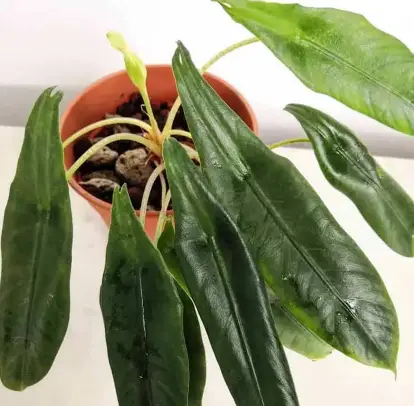
Small and growing to a height of 12 to 28 cm (5-11 in), Alocasia beccarii has thin stems with internodes that are broader than long, measuring 5-10 mm (1⁄5–2⁄5 in) in diameter. It bears numerous leaves occasionally, usually with lanceolate cataphylls up to 5 cm (2 in) long that dry to a reddish-brown color. These thin, leathery leaves have an elliptic to teardrop form, are up to 18 cm (7 in) long and 6 cm (2 in) wide, and are mid-green above and pale below.
This Borneo native is best found growing on low-elevation slopes, usually with rocks around, especially on sandstone.
19. Alocasia boa
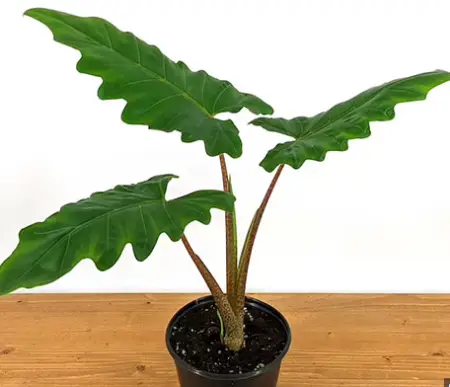
Alocasia boa grows to a height of around 1 m (3 ft) and is a reasonably resilient plant. Its erect to decumbent, bare, dark brown rhizome can reach lengths of up to 1.5 meters (5 feet) and widths of up to 4 centimeters (1.5 inches). It has up to six leaves that have somewhat serrated edges and arrowhead-shaped, shallowly pinnatifid blades with lobes about as wide as they are deep. A single major vein that runs to the leaf blade’s slightly rounded tip is present. New Guinea is home to this species.
20. Alocasia boyceana
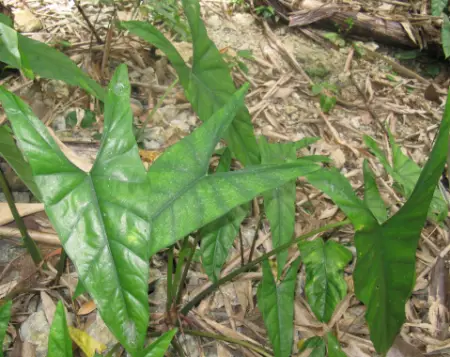
The somewhat robust herb Alocasia boyceana reaches a maximum height of about 60 cm (24 in) with a stem diameter of about 2 cm (1 in). It typically yields one to three leaves, many of which have cataphylls. The blades have a thin arrowhead to slightly spearhead shape and can be as long as 35 centimeters (14 in).
It is native to the Philippines and grows best in rainforests with low to medium elevations, occasionally on limestone. It is commonly confused for Alocasia heterophylla due to its resemblance to Alocasia ramosii, with non-peltate leaves that have five to seven principal veins and sub-marginal veining at the leaf margins.
21. Alocasia brancifolia
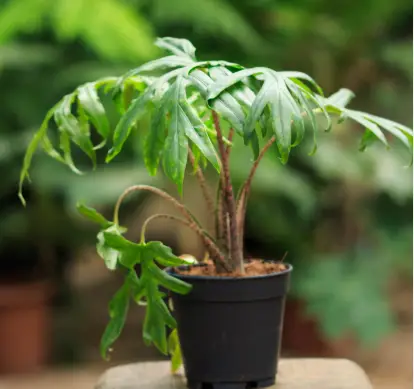
The treelet Alocasia brancifolia has six leaves on erect, brown stems that grow to a height of 1.2 meters (4 feet) and a diameter of 7 cm (3 in). The petioles, which are about 16 inches (40 cm) long, are sheathed in the lower third to half and can be green or brightly zebra-striped with chocolate brown. The leaf blades resemble an arrowhead.
This plant is interchangeable with many other species. It is indigenous to Indonesia, Papua New Guinea, and the Maluku Islands in New Guinea. It grows best in the understory of lowland forests, usually in marshy places but also sometimes in open spaces.
22. Alocasia brisbanensis
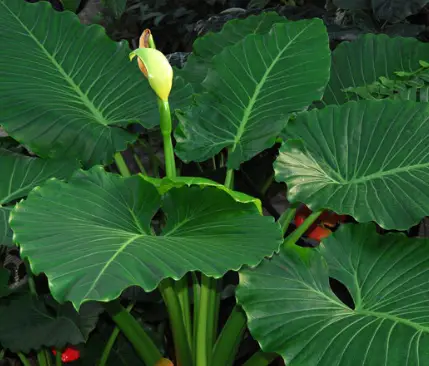
The large herb Alocasia brisbanensis has an upright to decumbent stem that is about 13 cm (5 in) wide and covered in ancient leaf bases. Its numerous leaves have complete borders, are membranous, seem pale to mid-green, and range in shape from arrowhead to fairly egg-shaped.
This plant has common names with a number of different species. It is indigenous to Queensland and New South Wales in Australia. It grows best in moist open areas in tropical, subtropical, and mild temperate rainforests, usually at low elevations and on pleiotropic soils.
23. Alocasia cadieri
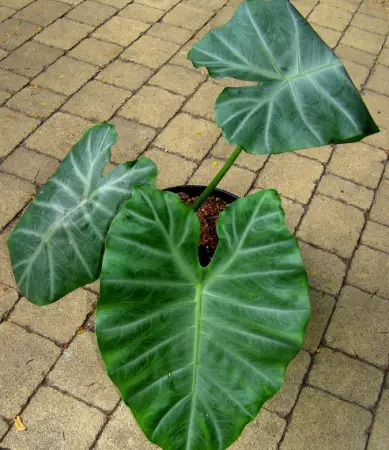
According to legend, Jule Chantrier brought Alocasia cadieri from the high plateaus of Annam (Central Vietnam) in 1938. Its olive green leaf blades and pale golden veins are accompanied by an upright and spreading habit and exceptional vigor.
24. Alocasia celebica
Growing to a height of approximately 1.5 meters (5 feet), Alocasia celebica has rhizomes that are 4 cm (1.5 in) wide and covered in ancient cataphyll roots. Papery fibrous marcescent cataphylls envelop its two leaves. Around 35 cm (14 in) long, the petioles have a mottled oblique zig-zag pattern, thick and minute pubescence, and a lower 1/4 sheath. The leaf blades are around 14 inches (36 cm) long, with an arrowhead to egg form, and a rather thick, leathery texture. The natural range of this species is in Indonesia’s Northwest Sulawesi.
25. Alocasia chaii
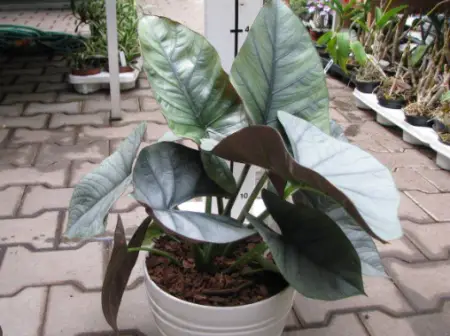
The compact, sturdy herb Alocasia chaii has a short, erect to decumbent stem that eventually develops into a short rhizome. It can reach a height of 40 cm. Cultivated plants can have up to seven leaves, but wild plants only have a few (up to four, generally fewer). The broad, ovate-elliptic leaves measure roughly 23 cm by 10-15 cm on average, and occasionally up to 25 cm in width. This native of Borneo grows at an altitude of 540–760 m (1,772–2,493 ft) on steep red clay-loam slopes in light to moderate shade. It resembles Alocasia scabriscula, but has smaller, peltate leaves and a persistent lower spathe that turns brilliant pink at ripening.
26. Alocasia chienlii
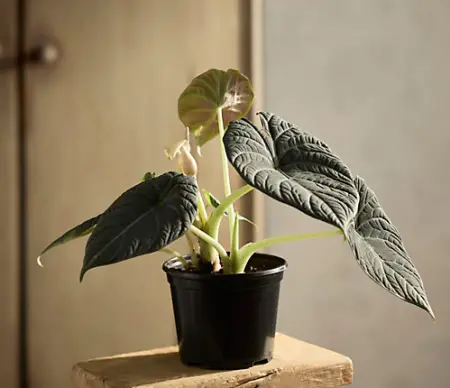
27. Alocasia clypeolata
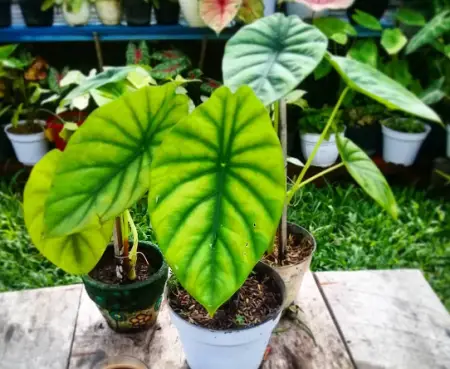
Alocasia clypeolata is a small herb that reaches a maximum height of 30 cm (12 in) and a minimum stem length of 5 cm by 2 cm (2 by 1 in) in width. It usually has six leaves, each of which has a petiole that is about seven inches (17 cm) long and sheathed in the lowest part. The egg-shaped, rather leathery leaf blades range in size from 16 by 6.5 cm (6 by 2.5 in) to 12 by 8 cm (5 by 3 in), with the darker portions along the major veins.
Despite having no link to Alocasia cuprea, this species is also known as Alocasia ‘Green Shield’ and Alocasia ‘Green Cuprea’. It is native to the Philippines and the Lesser Sundan Islands, where it grows at an altitude of 80 meters (262 feet) on rocky soil near the border of forests.
28. Alocasia cucullata
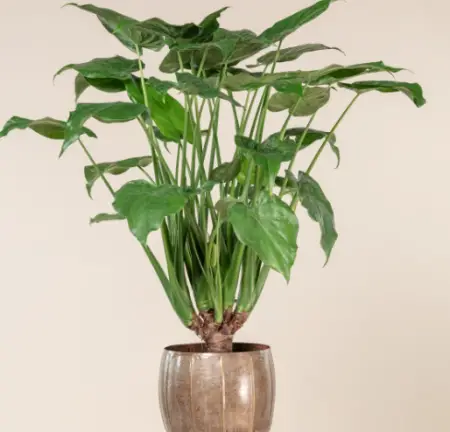
Alocasia cucullata is a clumping herb that grows up to 1 m (3 ft) tall with many leaves and upright, densely branched stems. The membrane borders of the weakly D-shaped petioles sheath them halfway up. The broad egg-shaped to heart-shaped leaves range in size from 10–40 cm by 7–28 cm (4–16 in by 3–11 in). It was first described in 1790 under the genus Arum, and it is also known by the names Alocasia rugosa and Caladium colocasia.
Alocasia cucullata grows well in many different places, such as Assam, Bangladesh, China, the East Himalaya, and Vietnam. It usually grows next to fields and water below 2,000 meters (6,562 feet).
29. Alocasia cucullata ‘Banana Split’
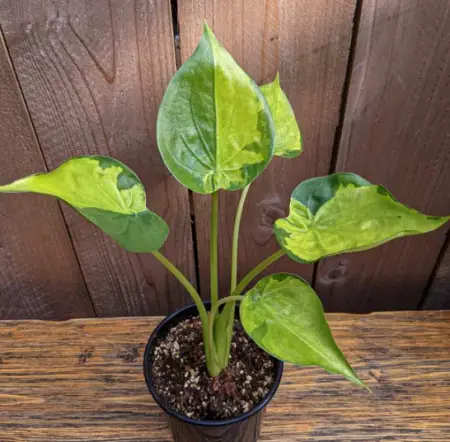
One cultivar of Alocasia cucullata is called “Banana Split.” It is distinguished by yellow variegation that can appear regionally or sectorally, with an irregular border that frequently continues into the center (color frequently stops at lateral veins).
30. Alocasia cucullata ‘Crinkles’
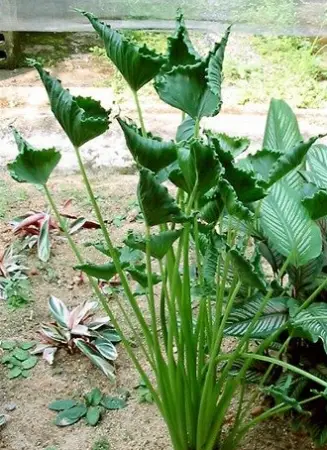
Although Alocasia cucullata ‘Crinkles’ is a cultivar of Alocasia cucullata, it is often offered under the incorrect name, Alocasia triangularis, which misleads growers into thinking it is a different species. Comparable to Alocasia macrorrhizos ‘Shock Treatment,’ this cultivar also has diamond-shaped leaves, ruffled/crinkled leaf edges, and a “cupped” leaf form as a result of a similar mutation.
31. Alocasia cucullata ‘Moon Landing’
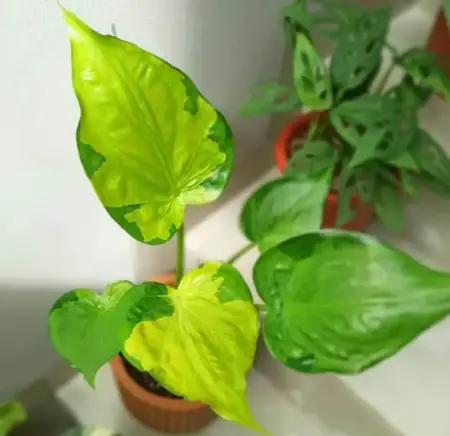
Distinguished cultivar Alocasia cucullata “Moon Landing” is distinguished by its distinct pale center, which is surrounded by an even green edge that never reaches into the center, giving the impression of a pale “moon.” Sadly, once its primary supplier, Asiatica, closed ten years ago, its scarcity has driven it to the verge of extinction. Due to its rarity and popularity, some vendors mistakenly refer to other variegated Alocasia cucullata as Alocasia “Moon Landing.” Its age also makes sellers confused because they might not know about the more recent cultivars.
32. Alocasia cucullata ‘Yellow Tail’
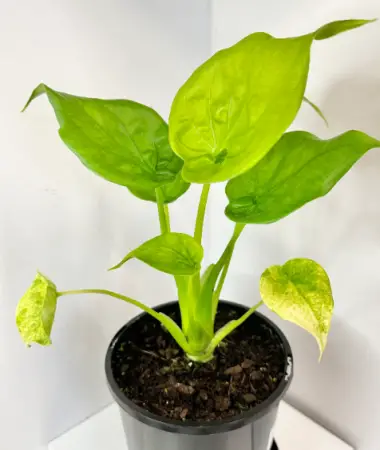
In contrast to the variegation of Alocasia cucullata “Moon Landing,” the cultivar of Alocasia cucullata known as “Yellow Tail” is distinguished by a green center and irregular pale yellowish variegation on the leaf margin.
33. Alocasia culionensis
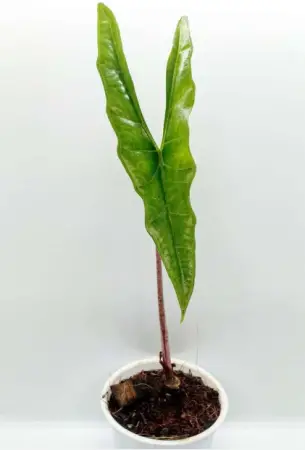
Alocasia culionensis is a rather strong herb that grows to a height of about 70 cm (27.5 in) and has upright stems that are about 2 cm (1 in) thick. It has numerous leaves with petioles that are roughly 45 cm (18 in) long and blades that are shaped like spearheads to arrowheads and measure 35 by 5 cm (14 by 2 in).
This native of the Philippines grows well on moist, shady ground in lowland rainforests. While it is similar to Alocasia heterophylla in inflorescence form, there are some differences, such as leaf size, shape of the posterior lobe, and secondary venation.
34. Alocasia cuprea
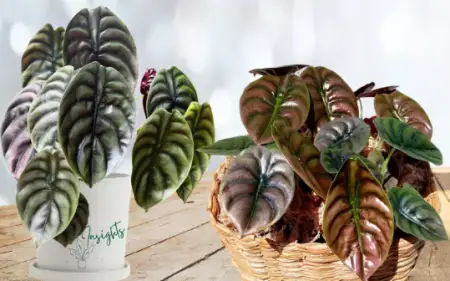
Since its debut in 1860, Alocasia cuprea, a well-known little Alocasia species, has been continuously cultivated. It has decumbent rhizomes that are approximately 6 cm (2.5 in) wide and reaches a height of around 80 cm (31.5 in). Its leathery, hanging leaves have shiny bronze-green undersides and are encircled by marcescent reddish-brown cataphylls. Usually found on the island of Borneo, it grows at elevations of 1,000–1,500 m (3,281-4,921 ft) on rainforest slopes close to sandstone, limestone, and ultramafic regions.
35. Alocasia decipiens
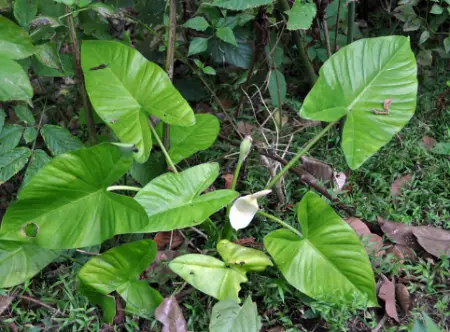
Alocasia decipiens, also known as Arum fornicatum, bears oblong, arrowhead-shaped leaves with rounded lobes. Its petioles are narrowly inserted about two-thirds down the leaf. This species thrives in regions such as the Andaman and Nicobar Islands, Bangladesh, Myanmar, and India, particularly close to limestone caves.
36. Alocasia devansayana
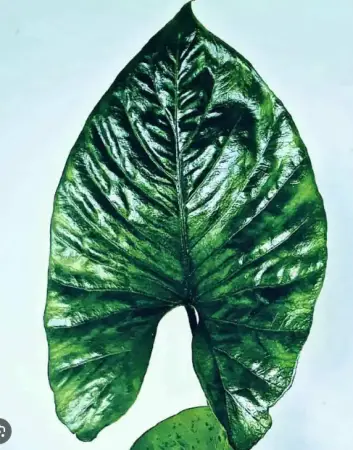
Colocasia devansayana, another name for Alocasia devansayana, is characterized by a short, tuberous rhizome with elongated, rounded, metallic petioles that are copper-brown in color. The blades of its shield-shaped leaves are flat and erect, twice as long as they are wide. This species is found in the forests of Mount Wilhelm in New Guinea, where it can be found between 800 and 1,750 meters (2,625 and 5,740 feet) above sea level.
37. Alocasia fallax
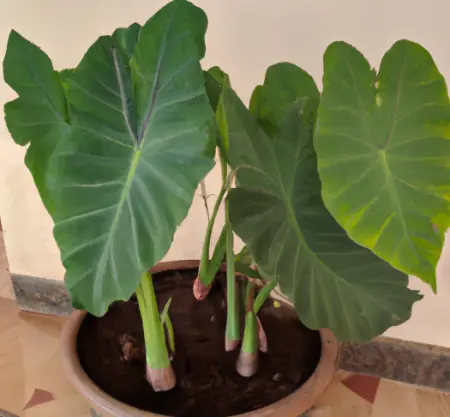
Alocasia fallax leaves have 7-9 pairs of nerves and range in shape from broadly egg-like to rounded arrow-like, reaching 30-50 cm by 23-30 cm (12-20 in by 9-12 in). The length of petioles is 30 to 60 cm (1 to 2 feet).
38. Alocasia farisii
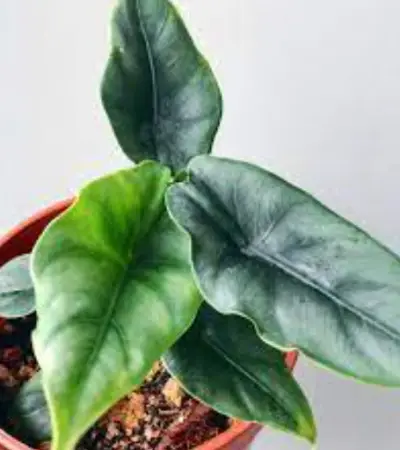
The epilithic herb Alocasia farisii can grow up to 55 cm (21.5 in) tall, however it is frequently shorter. The long, straight rhizome of this plant eventually becomes drooping. Unevenly spaced between leaves are marcescent cataphylls. The slender, shiny, leathery leaf blades have an arrowhead or egglike appearance. This species is unique to Kelantan, Malaysia. It grows at elevations of 80-160 m (262-525 ft) as a lithophyte on limestone outcrops and boulders, and occasionally as a terrestrial on seasonally dry Karst formations.
39. Alocasia flemingiana
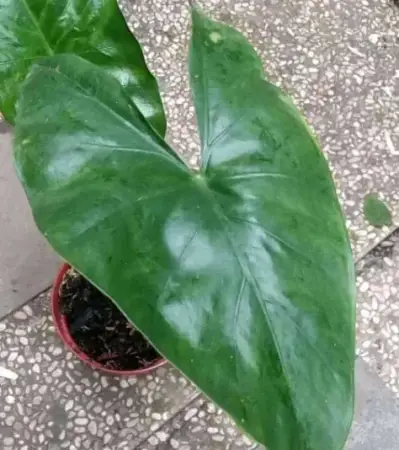
Alocasia flemingiana is a tiny herb with numerous leaves and rhizomes that are 3.5 cm wide. It grows to a height of around 50 cm. Usually green, the petioles might occasionally have streaks or mottling that is reddish-purple in color. The thin, glabrous, membranous leaves have morphologies varying from arrow-like to half arrow-like to egg-like, with a mid-green top and a greenish-yellowish underside.
This species is indigenous to Java, Indonesia, where it can be found in teak, swamp, and disturbed forests at heights of up to 1,000 meters (3,281 feet), frequently on volcanic soils and sometimes on limestone.
40. Alocasia fornicata
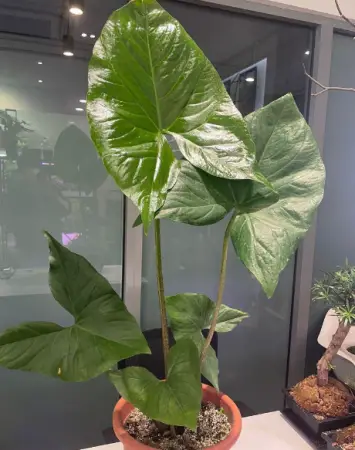
The perennial plant Alocasia fornicata is rhizomatous or tuberous, with large leaves that are covered in numerous nerves. A normal plant has triangular, broad leaves, a horizontal stolon, and somewhat pink petioles that grow to a height of 60–90 cm (2–3 ft).
Arum fornicatum and Colocasia fornicata are interchangeable with Alocasia fornicata. Assam, Bangladesh, India, Laos, Myanmar, Sri Lanka, Thailand, and Vietnam are among the places where it can be found.
41. Alocasia ‘Frydek-Bullata’
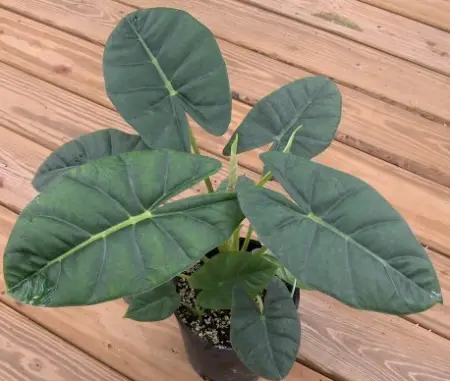
By Brian Williams, Alocasia ‘Frydek-Bullata’ is a cross between Alocasia micholitziana ‘Maxkowskii’ and Alocasia sinuata. When just emerging, its leaves have a satiny shine and are distinctly bullate.
42. Alocasia gageana
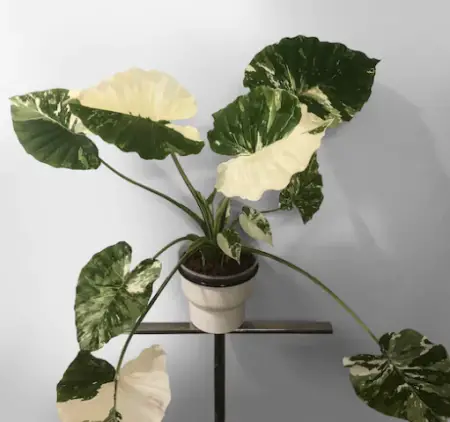
Alocasia gageana, sometimes called Alocasia ‘California’ or Alocasia ‘Californicus Corrugata,’ has green, flowing leaves with veins and a pronounced, sunken midrib. The leaves also have somewhat sinuated edges. It is indigenous to Myanmar and can endure long periods of time at temperatures as low as 5°C (41°F) without falling dormant.
Alocasia gageana is frequently confused with Alocasia macrorhizos; however, it may be distinguished by its sunken lateral veins, which contrast with the embossed ones in Alocasia macrorhizos, smaller and more oval leaves, and a semi-peltate sinus insertion on the petiole.
43. Alocasia ‘Golden Bone’
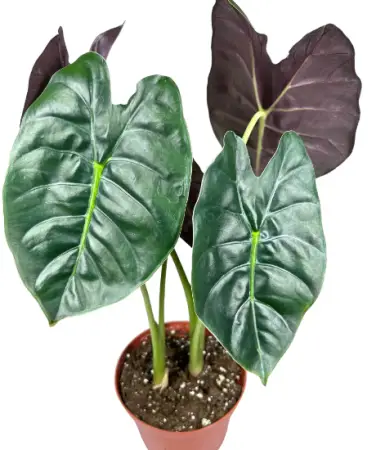
Between Alocasia micholitziana “Maxkowskii” and Alocasia cuprea, Alocasia “Golden Bone” is a naturally occurring hybrid.
44. Alocasia heterophylla
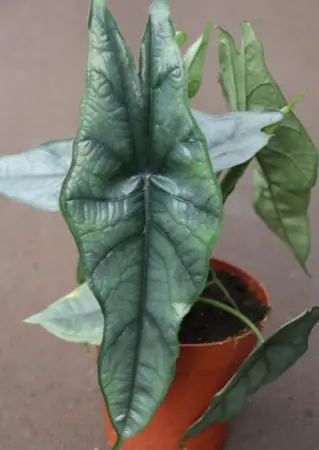
Alocasia heterophylla is a little herb that grows to a height of 40 cm (16 in) and a length of about 20 cm (8 in) on a decumbent to creeping stem. With petioles that are about 35 cm (14 in) long and sheathed in the lower to third quarter, it normally produces three to five leaves. The narrow shape of the leaves, which range in length from 27 cm (10.5 in), is somewhere between an arrowhead and a spearhead. While some adult plants have leaves that are profoundly to shallowly peltate, others do not.
Alocasia manilensis, Alocasia warburgii, Caladium heterophyllum, and Colocasia heterophylla are synonyms for this species. It grows up to 300 meters (984 feet) in elevation in the lowland rainforests (dipterocarp woods) of the Philippines.
45. Alocasia heterophylla ‘Green Veins’
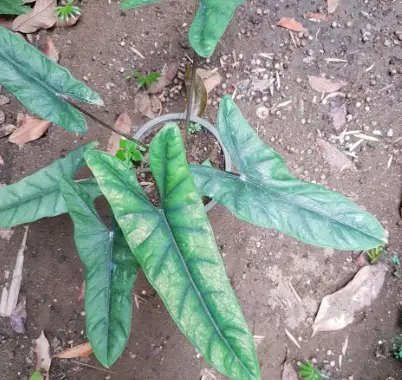
The cultivar known as “Green Veins” of Alocasia heterophylla is distinguished by thick, glossy, leathery green leaves that have an arrowhead shape and a distinct contrast between the leaf surface and the veins and midrib.
46. Alocasia heterophylla ‘Green’
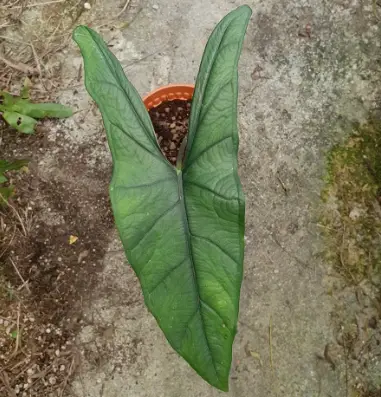
Phylogena Alocasia The thick, leathery, matte, arrowhead-shaped green leaves of the Alocasia heterophylla cultivar “Green” are its defining feature.
47. Alocasia heterophylla ‘Silver Kris’
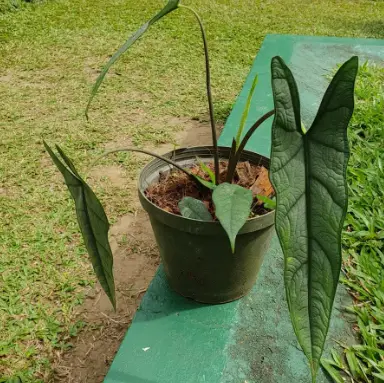
The heterophylla alocasia The arrowhead-shaped, leathery, matte green leaves of the Alocasia heterophylla cultivar “Silver Kris” have a distinct silver upper side. The leaves also have contrasting dark, embossed midribs, principal lateral veins, and visible secondary veins.
48. Alocasia heterophylla ‘Silver’
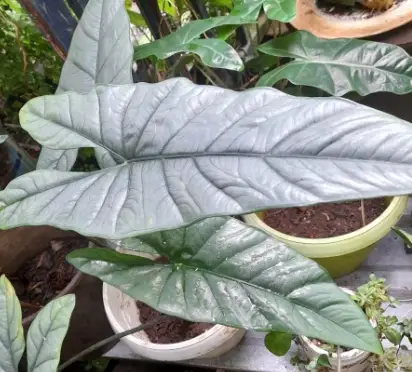
The heterophylla alocasia The arrowhead-shaped, glossy, leathery green leaves of the Alocasia heterophylla cultivar “Silver” have a distinct silver upper surface, a contrasting dark midrib, prominent secondary veins, and primary lateral veins.
49. Alocasia hollrungii
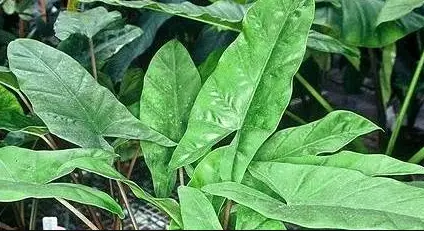
With decumbent rhizomes that range in width from 4 to 10 cm (1.5 to 4 in), Alocasia hollrungii is a robust and compact plant. It normally produces six different-sized and shaped leaves. Around 90 cm (35 in) long, the petioles have sheathing on the lower half and a ridge along the upper surface. They are typically green to bronze in color, although they can also be purple-black or pinkish-mottled on occasion.
The Bismarck Archipelago, located off the northeastern coast of New Guinea, is home to this species. It grows well in lowland environments such as rainforests, gaps, borders of forests, regrowth, and plantations, where it frequently appears as a weed.
50. Alocasia hypoleuca
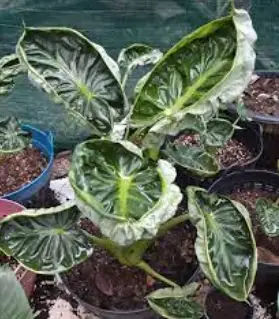
Alocasia hypoleuca is a large, evergreen herb that can grow up to 3 meters (10 feet) tall with a robust stem. It features a self-supporting stem with clustered leaves at the top that reaches about 2 meters (6.5 feet) in height. The light green leaves are roughly 100 by 50 centimeters (3 by 1.5 feet) and broadly triangular, like an egg-arrowhead. It is native to Thailand and grows best in 500 m (1,640 ft) of granite in dry evergreen woods. distinguished by its tall, slender, self-supporting stems from Alocasia macrorrhizos.
51. Alocasia indica
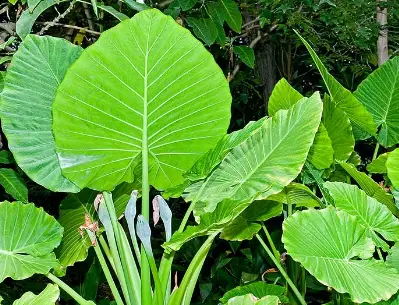
Alocasia indica, which has been used for food and medicine in India for a long time, has leaves that resemble a cross between an egg and a heart. The leaves are 60 to 90 cm (2 to 3 feet) long and have broad, egg-shaped basal lobes, also known as auricles. This plant, which is native to Assam, Bangladesh, East Himalaya, India, Jawa, Laccadive Islands, Myanmar, and Vietnam, is also known by the names Alocasia metallica, Arum indicum, Alocasia variegata, and Colocasia indica. Nonetheless, the majority of botanists reject it, viewing it as a synonym for Alocasia macrorrhizos.
52. Alocasia infernalis
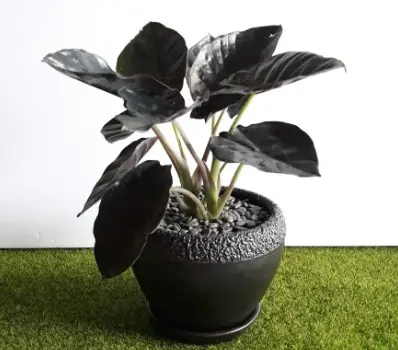
Compact but hardy, Alocasia infernalis grows to a height of 55 cm (22 in). With up to 12 leaves in cultivation, its slender stem grows straight at first before bending. When it is young, its leaves spread out, but when it is mature, it remains upright. The 20 cm (8 in) long petioles have a bronze-green to purple-green color, and in intense light, they may even have a snakeskin pattern. Its glossy, deeply purple, egg-shaped leaves can grow up to 25 centimeters (10 in) in length. Juveniles have almost no peltate texture, while adults have a lot of peltate.
This species is found in lowland woods in heavy shade at 182-249m (597-817 feet) above sea level in Sarawak, Malaysia, on clay loams produced from red sandstone.
53. Alocasia inornata
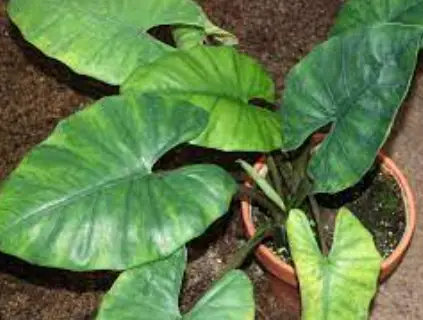
The strong Alocasia inornata, also called Alocasia nobilis, grows to a height of 1.3 meters (4 feet) and has four to five broad, heart-shaped leaves that resemble arrowheads. Its pale green petioles have a green line on the upper surface that is covered in short fuzz, and they are heavily speckled with purple-violet toward the tip. This species is highly versatile and may survive in a range of habitats from sea level to 1,200 meters (3,937 feet), including disturbed forests, wetlands, and riverbanks in Peninsular Malaysia and Sumatra, Indonesia.
54. Alocasia ‘Kalila’
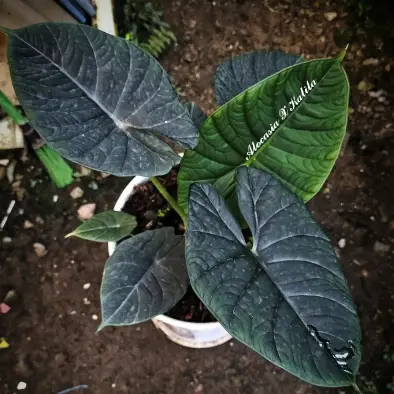
Between Alocasia reginula “Black Velvet” and Alocasia ‘Bisma,’ Alocasia ‘Kalila’ is a hybrid. Bedy from Kalila Flower in Kalimantan was the one who initially hybridized it. Alocasia ‘Ulla’ and Alocasia ‘Katya,’ two other cultivars, were also generated by the same cross.
55. Alocasia ‘Katya’
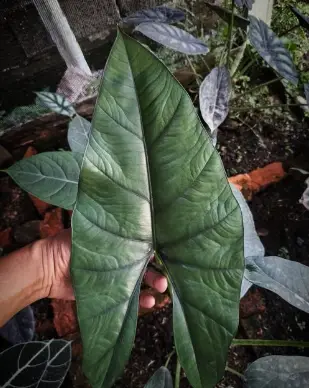
Alocasia reginula “Black Velvet” and Alocasia “Bisma” have hybridized to become Alocasia “Katya.” Bedy originally hybridized it from Kalila Flower in Kalimantan. Two further cultivars, Alocasia ‘Kalila’ and Alocasia ‘Ulla,’ were also generated by the same cross.
56. Alocasia kerinciensis
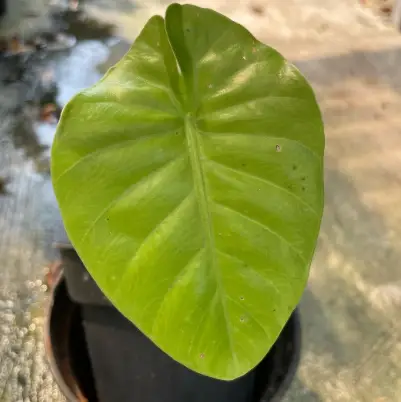
The tiny herbaceous plant Alocasia kerinciensis has leaves arranged in between thin, membrane-covered cataphylls. The lowest fifth of the leaf partially sheaths its 25 cm (10 in) long petioles. The peltate, broadly to narrowly egg-shaped, 13–16 cm by 6–9 cm (5–6 in by 2.5–3.5 in) leaves have a stiff, dull mid-green appearance. This species is found in Indonesia’s West Sumatra and Jambi Provinces, between G. Kerinci and Lake Kerinci, at a height of 1,500–2,000 m (4,921-6,562 ft).
57. Alocasia lancifolia
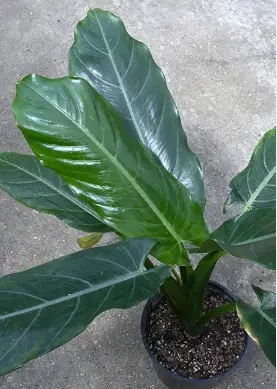
The somewhat robust plant Alocasia lancifolia usually produces 5–11 leaves on 6 cm (2.5 in) thick stems. Of its shorter blades, half are sheathed by its petioles, which are around 35 cm (14 in) long. The leathery, glossy, mid-green leaves are shaped like rounded lance heads, reaching a maximum length of 50 cm (20 in) (sometimes less) and a maximum width of 14 cm (5.5 in). This species is extensively distributed throughout New Guinea and can be found up to 600 meters (1,970 feet) above sea level in lowland rainforests, open swamps, and by forest streams.
58. Alocasia lauterbachiana
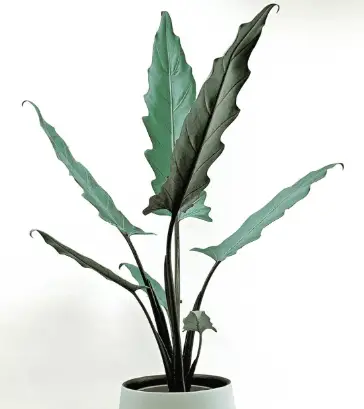
Alocasia lauterbachiana, sometimes called Alocasia wavriniana, Schizocasia lauterbachiana, Xenophya lauterbachiana, or Alocasia “Purple Sword,” is a plant with erect brown stems that can grow up to 1.5 meters tall with around six leaves grouped at the top. Chocolate-brown mottling can be seen on its 40 cm long petioles, and its leaves have a narrow pointed shape, serrated margins, and a bright bronze-green top surface that is contrasted with a dark purple underside. It grows best in lowland rainforests, especially those near rivers and forest borders. It is native to Northern New Guinea and the Bismarck archipelago.
59. Alocasia ‘Lukiwan’
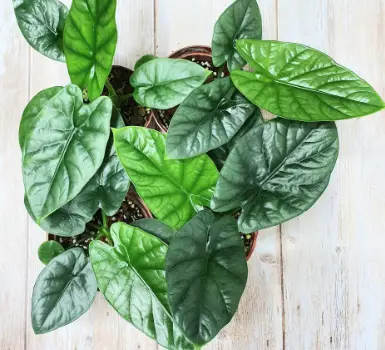
Alocasia alba and Alocasia sinuata are hybridized to create Alocasia “Lukiwan.” Wawan initially hybridized it while employed from 2001 to 2016 at the Chong Lee Nursery in Malaysia.
60. Alocasia maquilingensis
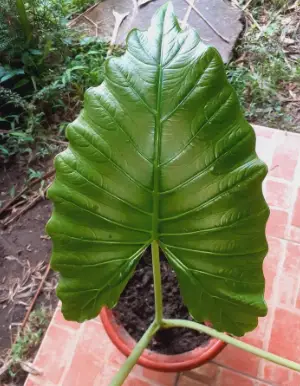
Alocasia vulcanica, often referred to as Alocasia maquilingensis, is a robust herb with leaf clusters and no scattered cataphylls. Sheathed in the lowest third to half are its 1 m (3 ft) long, thickly pubescent to glabrescent petioles. The broad, egg-to-arrowhead-shaped leaves are between 55 and 90 cm (22 and 35 in) long. It is native to the Philippines, specifically to Luzon, Mindanao, Leyte, and Panay. It grows best at low to medium elevations on slopes in primary rainforests.
61. Alocasia melo
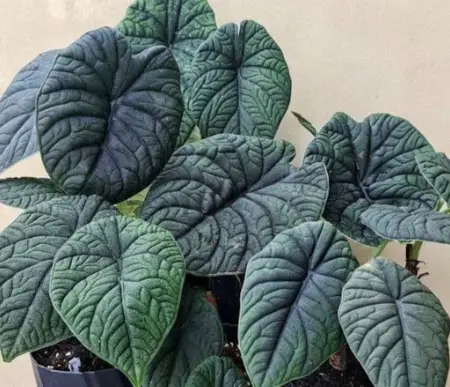
Alocasia melo, sometimes referred to as Alocasia rugosa or Alocasia “Rhino Skin,” is a plant that grows to a height of 25 to 35 cm. It has four overlapping leaves and a compact, erect stem. The glabrous, pale green petioles are 14–19 cm long with a few sparse burgundy dots near the base. Its leathery, peltate leaves are wrinkled and blistered. They are 18–25 cm long and 15 cm broad, with a bluish-green color on top and a pale greenish-white color underneath. This species is rare and significant locally since it lives in Sabah, Malaysian Borneo, mostly in lowland rainforest and along stream banks at elevations between 120 and 400 m (394 and 1,312 feet) above sea level. It prefers high temperatures, humidity, and shade from direct sunshine.
62. Alocasia micholitziana
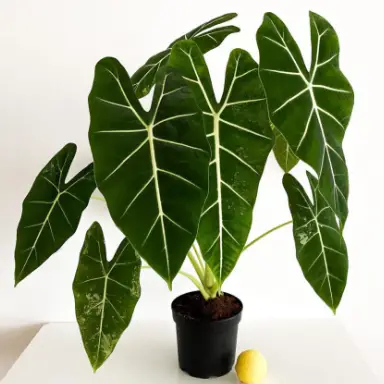
Alocasia micholitziana is a rather strong herb with an erect to decumbent 4 cm (1.5 in) diameter stem. It is also known by the names Alocasia “African Mask,” Alocasia “Green Velvet,” Alocasia “Green Goddess,” and Alocasia “Silver Vein.” Displaying four to seven cataphyll-free leaves, the lowest quarter to third of the plant is covered in 45 cm (18 in) long petioles that are mottled in brownish, reddish, and/or purplish shades. The smooth, glossy, deep green leaf blades are shallow to shallow peltate in shape and are around 40 cm long by 13 cm broad (16×5 in). It is native to the Philippines’ Luzon island, where it grows in primary and secondary forests as well as in roadside clearings at elevations between 1,200 and 1,500 meters (3,937–4,921 feet). This species is widespread and frequently encountered, maybe occupying a wider altitudinal range than the scant data that is currently available.
63. Alocasia micholitziana ‘Frydek’
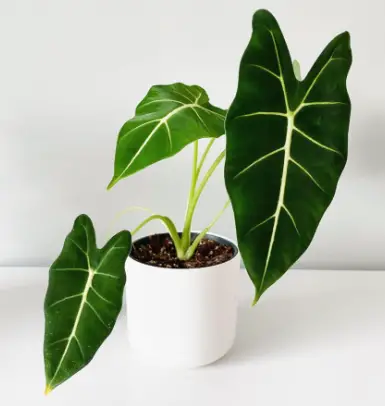
Along with the distinctive white veins and dark green velvet leaves of Alocasia micholitziana “Maxkowskii,” Alocasia micholitziana ‘Frydek’ is a rare variegated cultivar of Alocasia micholitziana. It is distinguished by white, mint, or yellow variegation.
64. Alocasia micholitziana ‘Maxkowskii’
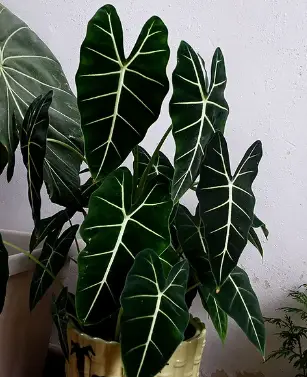
The most popular cultivar of Alocasia micholitziana, known as “Maxkowskii,” is distinguished by noticeable white veins on a dark green velvet leaf surface.
65. Alocasia minuscula
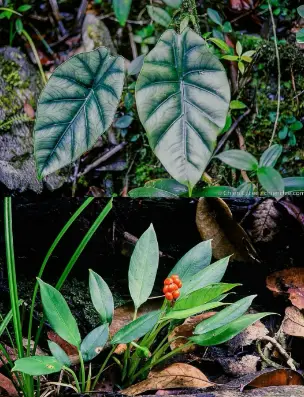
With a height of 10–20 cm (4–8 in), Alocasia minuscula is a little plant. Old leaf bases and marcescent cataphylls cover the suberect, condensed stem, which is about 1 cm (1⁄5 in) wide and has roots all the way up it. With papery membranous cataphylls strewn throughout, it has up to nine leaves. 5–10 cm (2-4 in) is the length of a petiole. Measurements: 8-13 cm by 2-3 cm (3-5 in by 1 in), peltate, leathery, narrowly egg-shaped, roundly lanceolate.
Native to the island of Borneo is Alocasia minuscula. Lowland peat swamp forest is where it grows.
66. Alocasia monticola

The plant Alocasia monticola grows to a modest height of 30 cm (12 in) and 3.5 cm (1.5 in) in width, with erect or decumbent rhizomes. Its six leaves each have 45 cm (18 in) long petioles that are green with occasional dark red mottling. The leaf blades are held horizontally and have a characteristic pointed shape, occasionally resembling an arrowhead shape.
New Guinea is the native home of this species. It grows in the understory of the lower montane rainforest, mainly in moist areas.
67. Alocasia navicularis
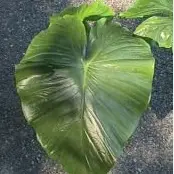
Known also as Colocasia navicularis, Alocasia navicularis is distinguished by its impressive girth, evergreen status, and tall 1.5 m (5 ft) height. It also secretes milky latex. At the top of the bigger plant stems, where petioles can reach up to 1.5 meters (5 feet), leaves gather. The peltate leaf blades are heart-shaped and measure approximately 130 by 120 cm (51 by 47 in). It is native to Assam, Bangladesh, China (South-Central), India, Laos, Myanmar, Nepal, Thailand, and Vietnam. It grows best in lower-montane forests that are damp and evergreen, sometimes on limestone.
68. Alocasia nebula
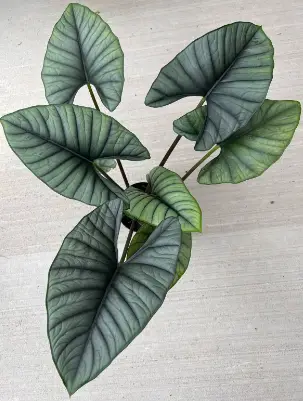
The Alocasia nebula has a stem that is 2.5 cm thick and 20–30 cm tall. Six glabrous leaves with deep purple dots appear, held up by 15 cm long, dull, pale green petioles. The leathery, egg- to arrowhead-shaped leaf blades are dark reddish-purple underside and have a matte gray-green color on top.
This species, also known as Alocasia guttata var. imperialism, is found on limestone surfaces in Borneo’s low-elevation rainforest floors.
69. Alocasia nicolsonii
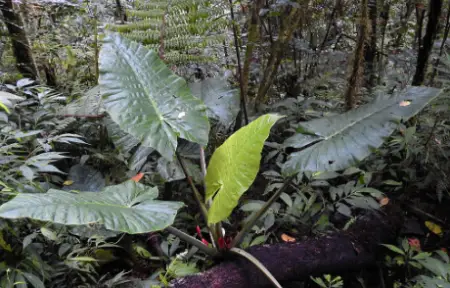
A strong Alocasia nicolsonii produces up to 12 leaves from an 8 cm (3 in) decumbent rhizome. Petioles measure 90 cm (35 in) and are covered in fibers or old leaf roots. They have sporadic glands on the upper surface. The arrowhead-to-egg-shaped leaves have paler undersides, dull to slightly glossy green upper surfaces, with sporadic reddish-purple colors.
Originating in New Guinea, it thrives in damp mid-montane rainforests at elevations between 1,700 and 2,700 meters (5,577-8,858 feet). Among the characteristics that set Alocasia nicolsonii apart from other Alocasia species are its delicate appendage, reddish fruiting spathe marked with synandria, and dissolving sheath.
70. Alocasia nycteris
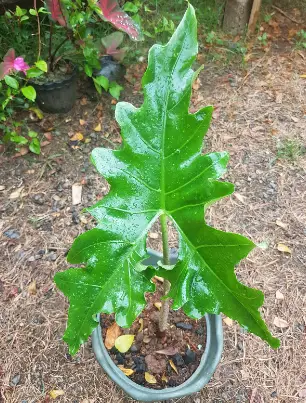
The 1.5 m (5 ft) tall Alocasia nycteris has stems that are 2 cm (1 in) wide and can be upright or drooping. Its 1 m (3 ft) long petioles, which are covered for 25% of their length, have streaks of blackish-green color. The coriaceous leaves have a dark glossy green color and can grow up to 37 cm (14.5 in) in length. They are shaped like spearheads to arrowheads.
Known also as Alocasia ‘Batwing’ and Alocasia advincula, this species is native to the Philippines. It grows well in secondary woods, rocky places, roadside shady spaces, disturbed secondary forests close to rice fields, and residual lowland forests.
71. Alocasia odora
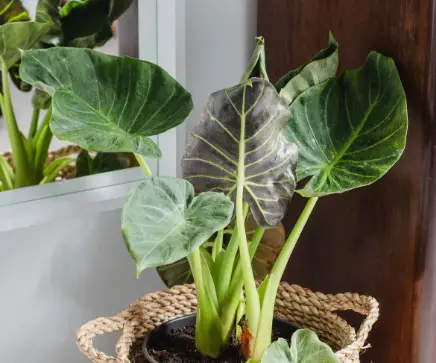
Caladium odoratissimum, Caladium odorum, Alocasia commutata, Alocasia subodorata, Alocasia tonkinensis, Arum odoratum, and Alocasia odora are all synonyms for Alocasia odora. Assam, Bangladesh, Borneo, Cambodia, China Southeast, China South-Central, East Himalaya, Hainan, India, Japan, Laos, Myanmar, Nansei-shoto, Taiwan, Thailand, and Vietnam are among the places where this species can be found.
72. Alocasia odora ‘Blue’
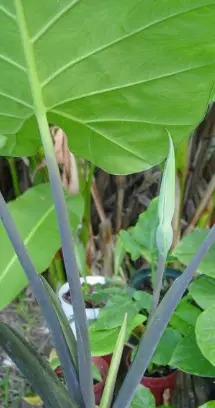
Alocasia odora ‘Blue’ is a Yunnan, China-born cultivar of Alocasia odora. Its name derives from the bluish hue seen in the peduncles and petioles, which occasionally even extends into the leaf’s major veins. When the plant is cultivated in shadow, its color is most visible. Comparatively speaking to Alocasia odora, the leaves are thinner and feel more papery.
73. Alocasia odora ‘Indian’
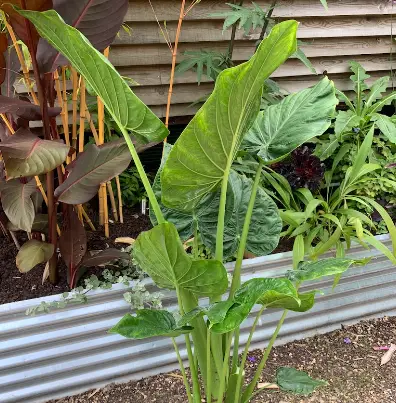
One cultivar of Alocasia odora is called “Indian.” Alocasia cucullata and this cultivar are similar, but the former grows considerably larger, has a lighter overall shade of green, and has many more blooms than the latter.
74. Alocasia odora ‘Okinawa Silver’
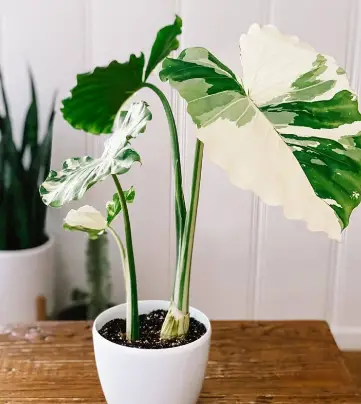
“Okinawa Silver” is the sole variegated cultivar of Alocasia odora. It grows significantly smaller than Alocasia odora, white-variegated Alocasia macrorrhizos, or white-variegated Alocasia gageana. The largest specimen, according to Alan Galloway’s report, was 1 m (3 ft) high.
Alocasia odora ‘Okinawa Silver’ is difficult to distinguish from other cultivars of Alocasia odora, Alocasia gageana, or Alocasia macrorrhizos because of the asymmetry between the white and green sectors.
75. Alocasia pangeran
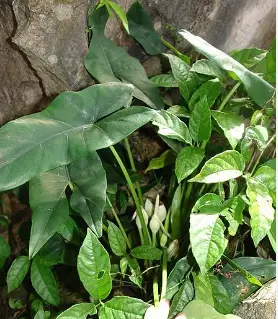
The 60 cm (24 in) tall Alocasia pangeran has four flexible leaves that can be shaped like spearheads or arrowheads. Its whitish lower surface contrasts with its dark green upper surface, which measures 20–35 cm (8–14 in). It is a facultative lithophyte that only occurs in Sabah’s Madai Caves. It has smooth, dark green petioles that are about 60 cm (24 in) long. It lives in soil and humus pockets on limestone outcrops in mixed lowland dipterocarp woods at an elevation of 400 m (1,312 ft) above sea level. Unlike Alocasia princeps, it coexists with Alocasia wongii and Alocasia puteri and is distinguished by its calcicolous lithophytic habit, shorter build, thin inflorescence, longer lower spathe, and loose interstice.
76. Alocasia peltata
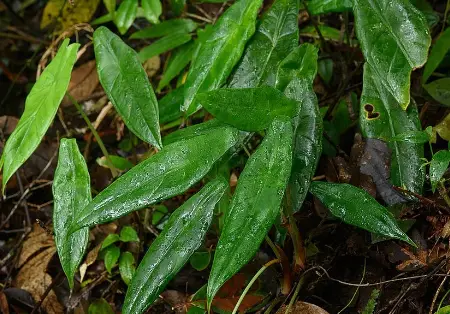
Alocasia peltata has a tall height of 30 cm (12 in) and a long, thin stem with internodes that are 2 cm (1 in) long. A few leaves alternate with papery lanceolate cataphylls along the stem. 12 to 28 cm (5-11 in) long, 3 to 10 cm (1-4 in) wide, glossy, green or purple peltate leaf blades with a whiter lower surface are supported by its 16 cm (6 in) petioles.
It is native to Borneo and grows on the mossy forest floors at an elevation of around 1,200 meters (3,937 feet), especially in isolated areas of central Kalimantan, Sarawak, and Brunei.
77. Alocasia peltata ‘Silver Grey’
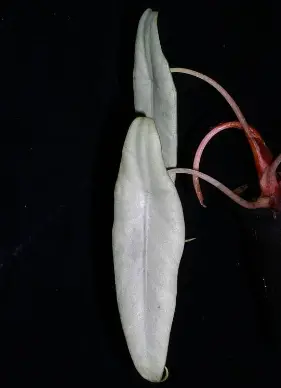
The cultivar of Alocasia peltata known as “Silver Grey” has leaves that have a silvery gray color.
78. Alocasia perakensis
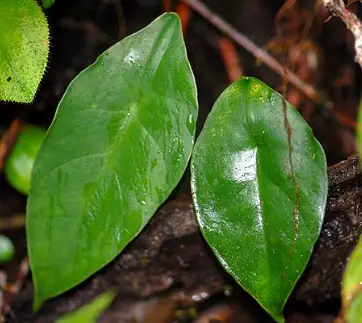
Alocasia perakensis grows semi-erectly and is usually 75 cm (29.5 in) tall, however it can grow smaller. Its roughly 2.5 cm (1 in) wide, creeper-like, elongated stalks are adorned with irregularly spaced lanceolate cataphylls. The semi-succulent, leathery, peltate, egg-shaped to elliptic, and varies in colors from dark green to grey-green, leaves are supported by 40 cm (16 in) long petioles that range in color from grey-green to purple-brown.
It is unique to Peninsular Malaysia, where it grows in montane forests at elevations of 1,100–1,525 m (3,600–5,000 ft), sometimes observed as high as 650 m (2,000 ft), where it is found on rocks and in leaf litter.
79. Alocasia perakensis ‘Silver Giant’
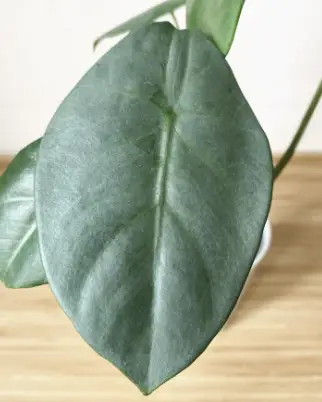
The larger-leafed, silvery-green cultivar of Alocasia perakensis known as “Silver Giant” was released by Silver Krome in 2021–2022.
80. Alocasia portei
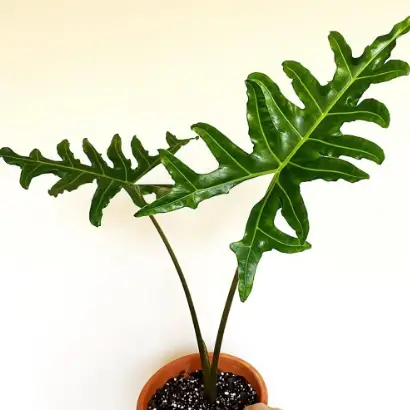
Alocasia portei, a massive arborescent pachycaul that rises to a height of 6 meters (20 feet), is also referred to as Schizocasia portei (1879), Schizocasia regnieri (1887), and Alocasia “Malaysian Monster.” Its base is around 40 cm wide, and as it gets older, it develops a tessellated “bark”. It has 1.5 m long petioles that are mottled with chocolate and range in color from yellow to dark green. Its leathery, dark green, arrowhead-shaped leaves have ruffled margins and are pinnately split.
It is native to Luzon, Philippines, and grows best in secondary forests at low to medium elevations.
81. Alocasia princeps
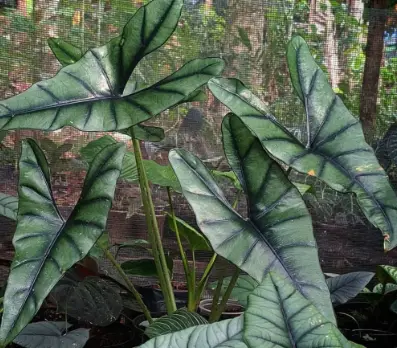
Rounded to 1.8 m (2.6–6 ft) tall, a sturdy Alocasia princeps yields roughly four leaves. Its suberect petioles are roughly 1.6 m (5 ft) long and have a dark brownish-green color with sporadic purple-brown spots and lines and a somewhat mottled, oblique wavy pattern.
When young, the pointed to arrowhead-shaped leaf blades, which are 55 cm (21.5 in) in length, are glossy, dark green, and leathery. Occasionally, a subtle purple flush appears beneath. Their form is triangular, and their edges are either smooth or somewhat wavy.
Similar to Alocasia porphyroneura, it is found in the common and extensive rainforests of Borneo. It prefers well-drained slopes and ridgetops with substrates like basalt and limestone, and it grows up to around 1,200 meters (3,937 feet) above sea level.
82. Alocasia princeps ‘Candy Sticks’
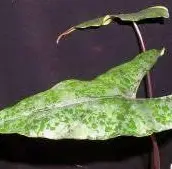
One cultivar of Alocasia princeps is called “Candy Sticks.”
83. Alocasia princeps ‘Purple Cloak’
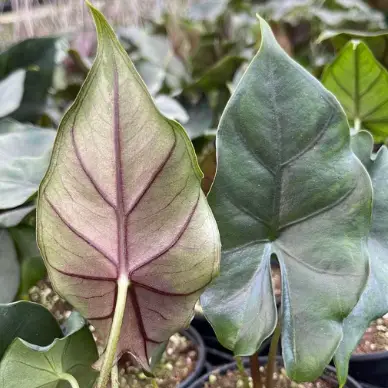
Salomon princeps Alocasia princeps has a cultivar called “Purple Cloak.”
84. Alocasia principiculus

The tiny lithophytic plant Alocasia principiculus has several leaves. Its petioles range in color from grey-green to dark purple-brown and are 20–30 cm long. Its leaves are narrowly triangular in shape, arrowhead to spearhead shaped, and around 25 centimeters long. The surface is thinly leathery, dull to slightly glossy, and clearly grey-green above and paler below.
This species is unique to Sabah, East Kalimantan, and Borneo. It grows from sea level to 600 meters (1,969 feet) above sea level in lowland rainforests and on and amid limestone stones.
85. Alocasia ‘Pseudo Sanderiana’
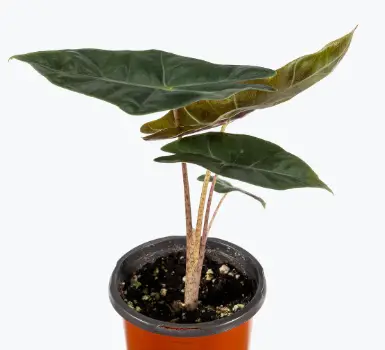
The Aroid Alocasia ‘Pseudo Sanderiana’ has arrowhead-shaped leaves that have purple undersides and a deep brownish green tint. Compared to Alocasia Sanderiana, it has more relaxed silver veining and less curved leaf margins.
86. Alocasia puber
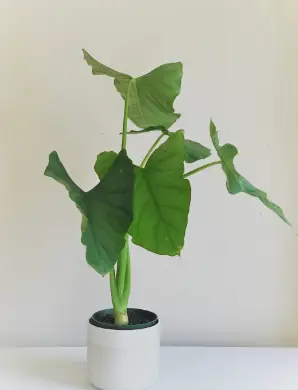
Alocasia puber is a sturdy Aroid that has several leaves and a stem that is 10 cm (4 in) thick. Its hairy petioles, which range in length from green to dark crimson, can reach up to 1.5 meters (5 feet). Typically, the arrowhead-shaped blades are 80 cm by 70 cm (32 by 28 in) in size.
Caladium pubigerum, Alocasia margaritae, Alocasia ovalifolia, and Alocasia crassinervia are synonyms for it. It is indigenous to Peninsular Malaysia, Southern Sumatera, and West to Central Java. It grows at elevations between sea level and about 1,000 m (3,281 ft), flourishing in open marshy areas and moist patches inside open woods.
People Who Read This Also Read:


